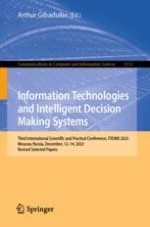2024 | Book
Information Technologies and Intelligent Decision Making Systems
Third International Scientific and Practical Conference, ITIDMS 2023, Moscow, Russia, December, 12-14, 2023, Revised Selected Papers
Editor: Arthur Gibadullin
Publisher: Springer Nature Switzerland
Book Series : Communications in Computer and Information Science
